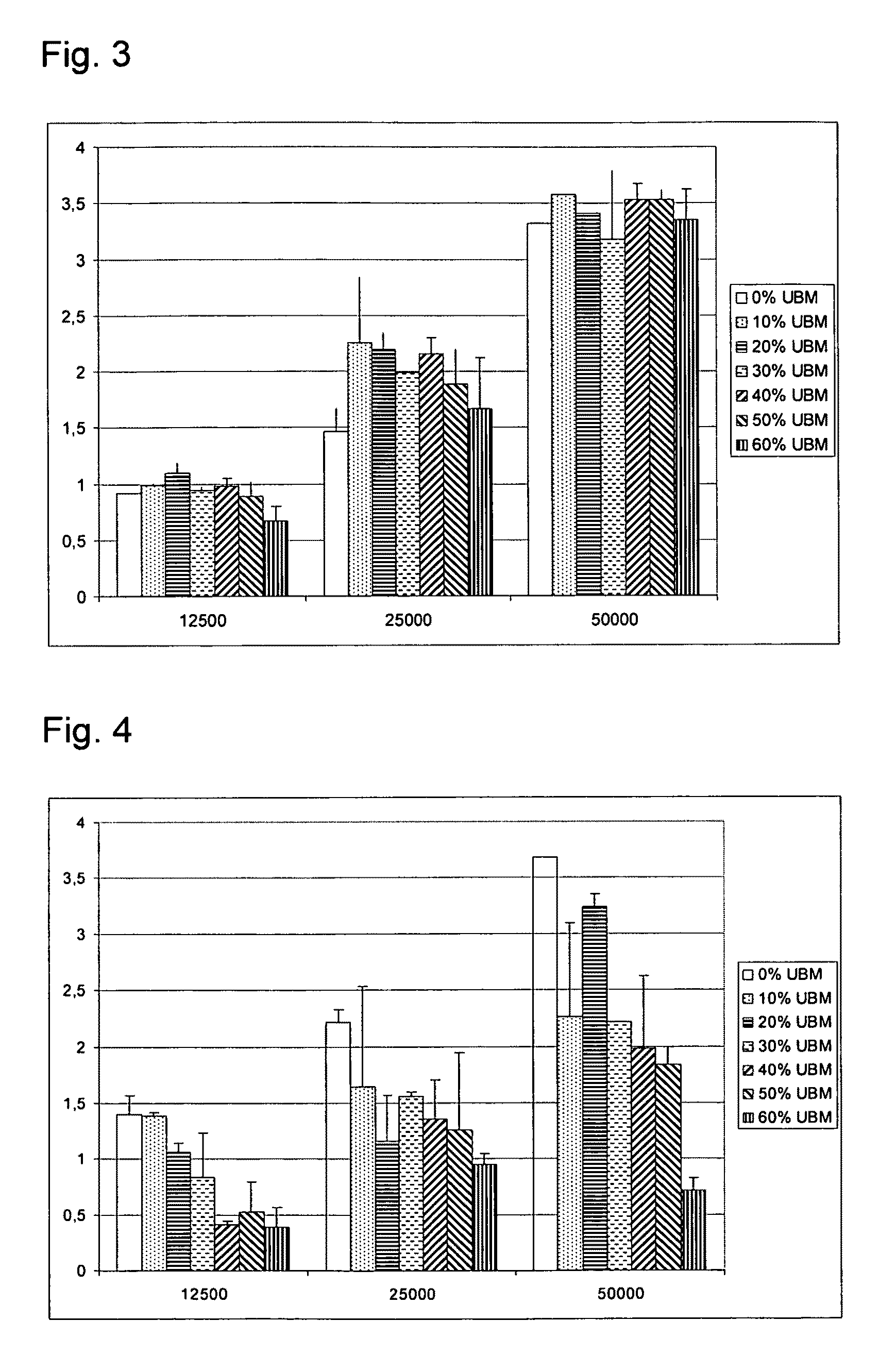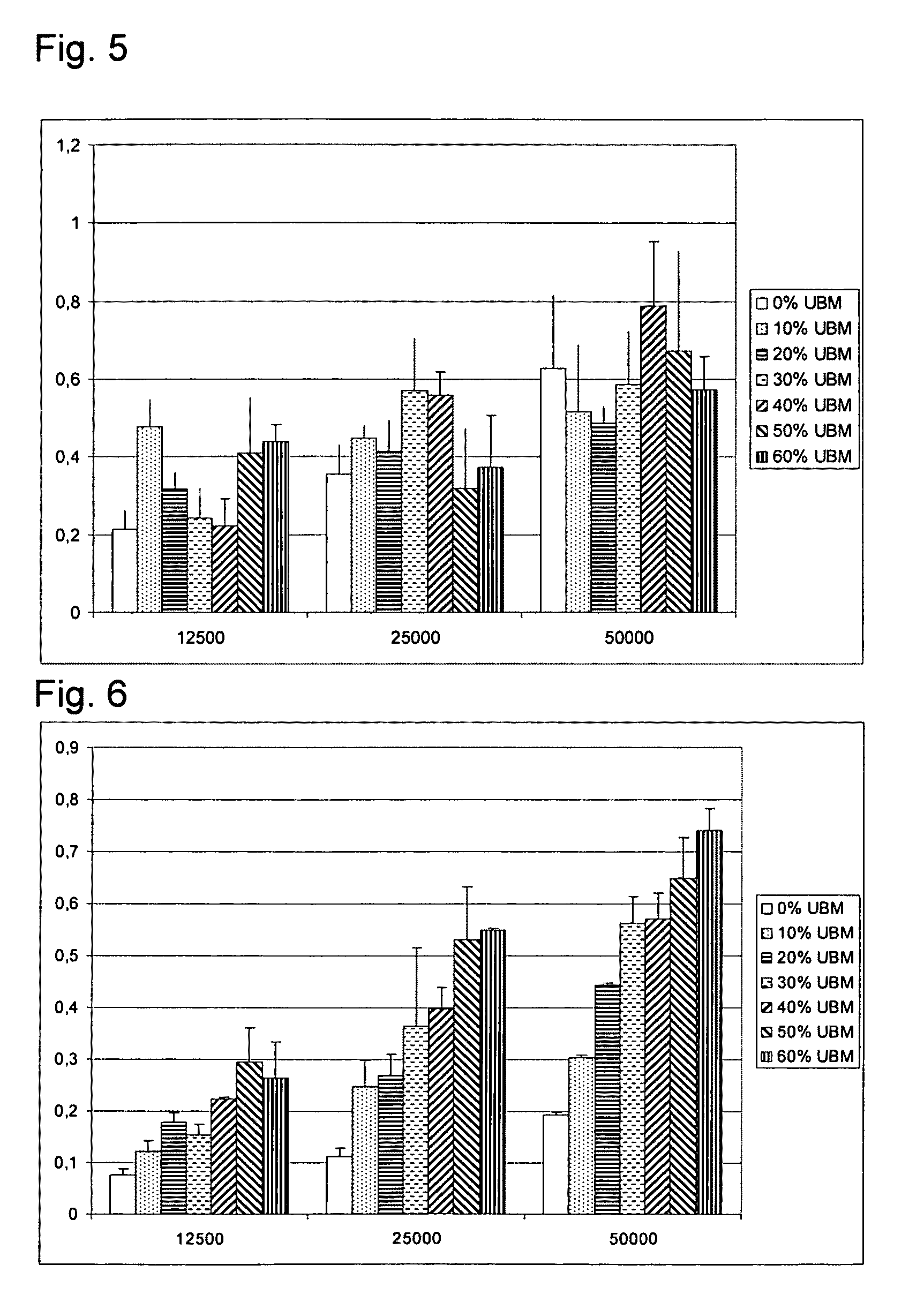Biodegradable scaffold with ECM material
a biodegradable, scaffold technology, applied in the field of scaffolds, can solve the problem that the concentration of ecm is surprising and does not give better cell morphology
- Summary
- Abstract
- Description
- Claims
- Application Information
AI Technical Summary
Benefits of technology
Problems solved by technology
Method used
Image
Examples
example 1
In-Growth of Primary Human Fibroblasts in Synthetic Scaffolds with and without ECM Particles
[0086]Scaffolds made of biodegradable polyesters containing UBM (Acell) particles (mean diameter of approximately 150 μm) at 40% (w / w) were compared with scaffolds without the ECM particles in a test of cell morphology and 3D growth.
[0087]Metoxy-polyethylene glycol—Poly(lactide-co-glycolide) (Mn 2.000-30.000, L:G 1:1) was dissolved in 1,4-dioxane to a 1.5% solution. For the UBM containing scaffold, 0.03 g UBM was added to 3 ml polymer solution (40% w / w drymatter), high-speed-mixed and poured in 3×3 cm mould. The solution was frozen at −5° C. and lyophilized at −20° C. for 5 h and 20° C. for approx 60 h. The samples were subsequently placed in draw (hydraulic pump) in a desiccator for 5 h.
[0088]The test of growth and morphology of seeded primary fibroblasts on the surface of the two scaffolds were evaluated.
[0089]Results from day 1, 3 and 7 were graded from 1-5, with 1 corresponding to worst c...
example 2
Cell Morphology and 3D Growth in Gelatine-ECM Composites Containing 5 Different Concentrations of ECM
[0091]A study of cell morphology and 3D growth of primary fibroblasts seeded on the surface of gelatine-ECM scaffolds. The gelatine scaffolds were cross-linked by heating and contained increasing concentrations of UBM (0, 12% (w / w), 26% (w / w), 41% (w / w), 51% (w / w) and 58% (w / w)). The concentrations were calculated as amount UBM in relation to total amount of solids meaning a 58% (w / w) scaffold contained 0.05 g polymer and 0.07 g UBM corresponding to 13.8 mg UBM / cm3.
[0092]Gelatin from porcine skin, type A, bloom 175 (Sigma) was dissolved in milli-Q water and t-BuOH (95:5) to a 1% solution. For UBM containing samples, the UBM was added to the solution while stirring (0, 12, 26, 41, 51, 58% w / w: 0, 0.007, 0.018, 0.035, 0.053, 0.07 g / scaffold). 5 ml of the UBM containing gelatin solution was poured into the mould (D=5 cm). The mould with the solution was placed in +5° C. for 1 h, then fr...
example 3
Preparation and Cell Morphology and 3D Growth in Composite Scaffolds of MPEG-PLGA or Gelatine Holding 6 Different Concentrations of ECM Particles
[0094]Preparation of composite scaffolds of gelatine and ECM: Gelatin from porcine skin, type A, Gelita pharmagrade 832 was dissolved in milli-Q water and t-BuOH (95:5) to a 1% solution. For UBM containing samples, the UBM was added to the solution while stirring; 0, 0.006, 0.013, 0.021, 0.033, 0.05, 0.075 g / scaffold (0, 10, 20, 30, 40, 50, 60% w / w). 5 ml of the UBM containing gelatin solution was poured into the mould (D=5 cm). The mould with the solution was placed in +5° C. for 1 h, then frozen at −20° C. and lyophilized at −20° C. for 5 h and at 20° C. for 18 h. The samples were subsequently cross-linked in vacuum oven at 130° C. for 15 h.
[0095]Preparation of composite scaffolds of MPEG-PLGA and ECM: Metoxy-polyethylene glycol-Poly(lactide-co-glycolide) (Mn 2.000-30.000, L:G 1:1) was dissolved in 1,4-dioxane to a 1.5% solution. For UBM ...
PUM
| Property | Measurement | Unit |
|---|---|---|
| thickness | aaaaa | aaaaa |
| density | aaaaa | aaaaa |
| mean diameter | aaaaa | aaaaa |
Abstract
Description
Claims
Application Information
 Login to View More
Login to View More - R&D
- Intellectual Property
- Life Sciences
- Materials
- Tech Scout
- Unparalleled Data Quality
- Higher Quality Content
- 60% Fewer Hallucinations
Browse by: Latest US Patents, China's latest patents, Technical Efficacy Thesaurus, Application Domain, Technology Topic, Popular Technical Reports.
© 2025 PatSnap. All rights reserved.Legal|Privacy policy|Modern Slavery Act Transparency Statement|Sitemap|About US| Contact US: help@patsnap.com



